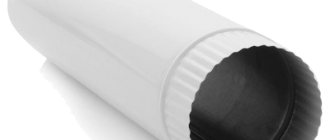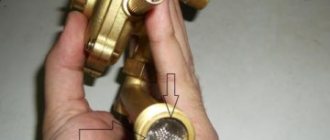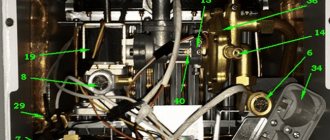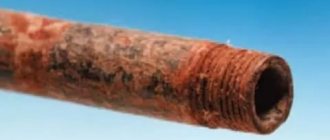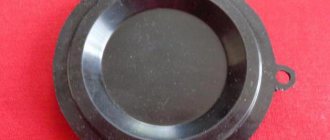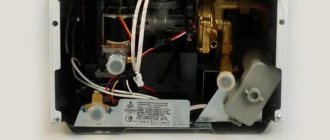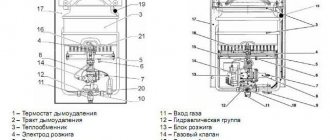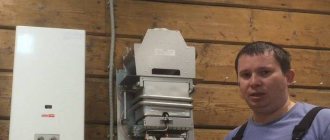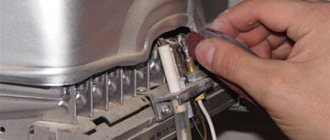According to the official opinion of the Ministry of Natural Resources and Environment of the Russian Federation, in 2034 gas will be the main raw material for energy. In this regard, the main task is the development of the extraction of this resource, as well as the gasification of our homes. In the southern regions of our country, two types of energy have long been used in parallel - electric and gas. This option is convenient and practical, especially in a private home. Whether you need gas equipment in your home is up to you to decide.
Knowing that gas can provide excellent insurance in case of interruptions in electricity, hot water, or heating in the apartment, the choice is obvious. The only condition for the safe operation of gas equipment is compliance with all regulatory rules, starting with installation of the system.
How is the selection and design of chimneys regulated?
Depending on your needs, you choose the right gas equipment, it can be:
- Gas boiler for heating the house.
- Gas water heater for heating water.
- Gas stove for cooking.
Below we will take a closer look at the types of ventilation ducts suitable for gas equipment, and everything you need to know about built-in hoods. As well as the installation of a smoke exhaust system that is safe to operate and meets the requirements of SanPin and fire inspection:
- SanPiN 2.2.4.548-96
- SanPiN 2.1.2.2645-10
- SP 89.13330.2012
- Instructions for PPR clause 2 chapter 1 of 2021
Selection principles
A corrugated pipe for a geyser is selected taking into account the following criteria:
- volume of exhaust gases;
- terms of Use;
- chimney height;
- temperature of combustion products;
- diameter of the gas equipment outlet pipe;
- the presence of aggressive or toxic elements;
- weight of the structure and load-bearing capacity of the walls.
Calculation of hood parameters
The exhaust power for geysers (m3/hour) is determined based on the formula:
, where S is the area of the room in which the equipment is located;
H - room height;
k is the number of air replacement cycles per hour, taken equal to 12, according to current standards.
The resulting value must be increased by 15–20%, since the equipment cannot constantly operate at maximum power. Gentle operating modes will extend the life of the column and increase the safety of its operation.
The volumetric flow rate of gas combustion products L is calculated as follows:
, where Qt is the selected power of the dispenser, kW.
Based on the volume flow, the diameter of the outlet pipe is determined. If there is no suitable model, then the closest one with higher performance is selected.
Average prices per set
A steel gas pipe with a diameter of 115 mm or more will cost approximately 17 thousand rubles, depending on the length, type of insulation, and the number of additional elements. A similar stainless steel set will cost from 19 thousand rubles. The cost of enameled steel structures starts from 65 thousand rubles, and aluminum ones - from 90 thousand rubles.
The price varies depending on the diameter of the chimney, configuration, and manufacturer.
Features of the chimney device
The ventilation system for removing waste combustion products and ensuring air flow in the room has the same device, whether it is a corrugated hood for a gas water heater or a solid brick chimney. The chimney must consist of the following parts:
- Feedthrough pipe.
- Pipe for removing combustion products.
- Adapter for connecting previous parts to each other.
- Crimp clamps and mounting brackets.
- Telescopic tubes.
- Tee with a hole in the region to remove condensate.
- Bends.
- Cone tip.
All parts can be attached one by one independently, without violating safety precautions, using special non-flammable materials. But it is better to turn to professionals.
How do chimneys differ from each other? The material from which the parts are made, the choice of pipe installation method and the geometry of the ventilation shafts.
Why does a gas water heater need a hood?
A geyser is a convenient device that allows you to provide residents of your home with hot water at any time of the year. Modern devices are equipped with temperature regulators, sensors for the operation of the water point and other convenient functions. But even the most modern unit will not protect against carbon monoxide if the chimneys in the house are not cleaned.
In addition, household gas is explosive, and if leaked, in a certain proportion with oxygen, it can provoke a disaster.
A hood will help solve the issue of removing combustion products and providing sufficiently high draft. It should be installed strictly in accordance with the requirements of regulatory documents.
The chimney of the column should not be confused with devices for other kitchen appliances that run on gas.
We will consider the advantages of built-in coal hoods for kitchen stoves in one of the following articles.
Chimney made of galvanized pipe
At the stage of designing ventilation for a gas water heater, when selecting a material, opt for a galvanized pipe. Taking into account the heating temperature when disposing of combustion products from the premises, a wall thickness of 0.5 millimeters is selected at a heating temperature of 400°.
When choosing pipes for a geyser, the configuration of the future hood is taken into account - single-circuit or double-circuit.
In the second case, the pipe is suitable for sandwich and coaxial chimneys.
They differ in that in a sandwich system basalt wool is laid between two pipes; in a coaxial chimney, on the contrary, air circulates. Due to their properties and ease of installation of gas water heater hoods, sandwich chimneys are popular today.
Types of exhaust pipes
Exhaust pipes can be of the following types:
- rigid, connected by fittings;
- flexible or corrugated;
- coaxial, which are a complex structure in which the outflow of combustion products is realized through one channel, and the influx of fresh air into the other.
Using corrugation is beneficial due to ease of installation, minimal number of connecting joints, and high level of tightness. Coaxial ones are the most expensive, but they do not require thermal insulation and are safe to use.
Corrugations for geysers are:
- stainless steel – resistant to corrosion, flexible, heat-resistant (up to +9000C), not exposed to acidic environments, and does not require the use of adapters for installation;
- aluminum - operated at temperatures up to +5000C, resistant to aggressive environments, corrosion, high humidity, the surface is easily scratched, deformed, high cost;
- enameled steel - heat-resistant, durable, have excellent aesthetic properties, the protective layer is not resistant to mechanical damage, it is necessary to monitor the integrity of the enamel;
- galvanized steel - do not require maintenance, are resistant to humidity, corrosion, and susceptible to mechanical damage.
Corrugated pipe for geyser
Coaxial chimney for gas boiler
As mentioned above, a coaxial chimney is a double-circuit pipe. Its operating principle is based on the influx of clean air masses through the distance between the pipes, and the release of carbon monoxide through the inner pipe. Using a coaxial hood for geysers in an apartment will help bypass the public ventilation duct, removing combustion products through the pipe to the street, and avoid a situation with a loss of boiler efficiency, which can occur if the ventilation duct is clogged.
It is important to know that when installing a closed-type gas boiler, only a coaxial chimney is installed.
For this system, a pipe with a diameter of 11 centimeters is used. Often, fans with sensors are installed for greater traction. This allows you to achieve high performance of the gas boiler at any time of the year.
What pipes are needed for ventilation?
First of all, you need to figure out where exactly the gas water heater will be located. Gas-powered equipment must not be installed in residential areas such as a bedroom or living room. Basically, speakers or boilers are placed in the kitchen, bathroom or hallway, if they comply with fire safety standards.
Ventilation for a geyser in an apartment or house is arranged using pipes:
- steel on fittings;
- flexible corrugated;
- coaxial.
Read here how an automatic gas water heater works?
Is it possible to organize gas heating in a wooden house?
Gas heating of the garage - implementation methods
…
When choosing an exhaust pipe for a ventilation device, you must keep in mind that similar products are produced with different diameters:
- 11 cm and 13 cm are standard sizes;
- 9 cm and less - for devices with a power of less than 19 kW that operate at one water intake point;
- more than 13 cm - for devices with a power of more than 21 kW.
The exhaust pipe can be installed with a rotation of 90°C. To do this, you should purchase a special knee, but this option has a significant drawback - it reduces the traction force.
When choosing a material for an exhaust pipe, you should rely on the mandatory requirements that apply to them:
- sufficient smoothness of the inner walls so that soot does not settle on them; high roughness creates conditions for the gradual accumulation of ash and soot, which leads to a narrowing of the pipe opening;
- resistance of pipes to high temperatures and toxic chemical compounds.
There are pipes of different qualities and prices on the market:
- Aluminum - they are light weight and inexpensive, but they burn out quickly, especially in high temperature conditions.
- Made of galvanized steel - provides protection against corrosion, has an affordable price, but when it operates at high temperatures, harmful substances can be released.
- Enameled steel is resistant to high temperatures, has good smoothness of the internal walls, but is not cheap.
- Stainless steel is the best choice for the hood. It is characterized by a long service life, high smoothness, resistance to chemicals and high temperatures.
Coaxial type chimneys consist of two pipes inserted into one another. The internal element is necessary to remove smoke, and the external element to supply air to the burner. It is better to give preference to a high-quality metal coaxial chimney that can last for many years than its cheap plastic counterpart.
…
Ceramic chimney
When using a ceramic chimney, you should understand that ceramics have a high percentage of moisture absorption. To increase its service life, it is necessary to install additional exhaust channels.
When installing an exhaust system, the ceramic pipe is wrapped in insulation and installed in an expanded clay or brick box.
It should be noted that this method of exhaust gas removal is expensive. And it is not suitable for a gas water heater located in an apartment.
We recommend that you read: Plate recuperator
Connection restrictions
The height of the pipe must be at least 2 meters.
Strict compliance with the rules is important when connecting the chimney yourself. If the installation of equipment is carried out in an individual home, preparatory work should be carried out during the construction stage.
- Each device must have an individual exhaust gas outlet channel. As an exception, it is allowed to combine two devices at a distance of 75 cm.
- The design of chimney ducts must comply with the requirements of building codes.
- The channels must be completely sealed. Brickwork is not 100% guaranteed.
- The draft inside the channel should be even. This is achieved by a round cross-section and the absence of roughness inside.
- The chimney material is made from condensate and acid resistant materials. In this case, uninterrupted operation and no leakage of combustion products are guaranteed.
- The diameters of the inlet and outlet holes must match.
- At the bottom of the chimney there is a place for cleaning, inspection and collection of condensate.
- According to SNIPs, gas outlet channels are located near fireproof partitions.
- During the installation of steel air ducts, it is assumed that adapters are used to exhaust the duct.
- The verticality of the pipe outside the room is allowed with a deviation of no more than 30 degrees or 1 m.
The chimney outlet must be placed on a flat roof with a height of at least 2 m. When installed on a gable roof, it must be at least 0.5 m above the ridge.
Requirements for smoke exhaust structure
The basic rules of SNiP 42-01-2002 and 2.04.08-87 approve the following requirements for installing gas boilers and connecting them to the hood:
- The ceiling in the boiler room must be at least 2.5 meters high.
- The area of the room for one piece of equipment must be at least 4 square meters.
- It is necessary to have a window with a window of at least 0.3 square meters in area. Otherwise, additional ventilation is required.
- The walls in the boiler room must be made of non-combustible materials.
- There must be an inspection window in the chimney system; such a device is installed at a distance of 0.25 meters from the chimney opening.
- You cannot connect several gas-powered appliances to the same ventilation system.
- The gas stove must be placed in another room, separate from the boiler at a distance of at least 6 meters. If these conditions are met, it becomes possible to cancel the previous comment.
Requirements for chimneys for geysers (SNIP)
Requirements for chimneys are set out in the following documents:
- SNiP 41-01-2003 in a new edition (SP 60.13330.2012);
- NPB 252-98 (fire safety standards);
- SP 42-101-2003;
- VDPO (rules for the production of pipe and furnace works).
The main provisions regarding the direct removal of smoke from household water heaters are collected in the following paragraphs:
- The cross-sectional area of the chimney pipe must be greater than or equal to the cross-section of the outlet pipe of the column;
- Laying gas pipes through living rooms is prohibited;
- The chimney system must be completely sealed, resistant to corrosion and temperatures up to 200°C;
- The vertical section of the chimney at the outlet of the column should not be shorter than 500mm. Only in some cases this figure is reduced to 250mm;
- The length of connecting pipes should not be more than 3 m in designed houses and no more than 6 m in existing ones;
- The design allows for no more than 3 turns with a radius of at least the pipe diameter;
- If the wall of the building is made of non-combustible materials, the distance from it to the exhaust pipe must be at least 5 cm, if the wall material is flammable - at least 25 cm. If the fire protection requirements of SP 42-101-2003 are met, the distance can be reduced to 10 cm;
- If the connecting pipe passes through an unheated room, it must be protected with thermal insulation;
- The slope of the exhaust pipe towards the column must be more than 0.01;
- You cannot use one hood for a gas water heater and a gas stove;
- The ceiling height in the room with a water heater and chimney should not be less than 2 m. Area – at least 7.5 m for one device, at least 13.5 for 2 devices.
Step-by-step instructions for constructing a smoke exhaust system
When commissioning the equipment, room ventilation must be taken into account. In the absence of air exchange, forced turbo exhaust must be installed. Without it, putting a gas boiler into operation is impossible. We will look at how to install a hood for a gas boiler in a private house using the example of a coaxial chimney. The length of the pipe from the boiler room to the street for this type of hood cannot be more than two meters.
- When starting work, make sure that the installation of the gas boiler complies with the rules and regulations approved by inspection organizations in order to avoid reworking the entire power unit.
- Select the appropriate material for the hood, taking into account the parameters of the gas outlet: gas boiler inlet = pipe diameter.
- Calculating the power of the fans and their number, taking into account how long the hood is, the number of bends in its structure, and the position in space relative to the horizon, at what height the exhaust pipe is located in the room.
- Do not forget about the features of budget equipment indicated in the technical passport.
- All materials used in the work must be fireproof and not susceptible to corrosion.
- After making sure that all parts are intact, we proceed to assembly. We connect the chimney elbow to the gas boiler pipe using a tee.
- To extend the coaxial pipe and connect all its parts, special crimp clamps and fire-resistant sealants are used.
- Turbo exhaust is used if there are more than two elbows in the pipeline geometry. This helps maintain the efficiency of the gas boiler . The fan and all sensors are installed after installing the supply pipe.
- Installing a coaxial pipe outside a building is no different from installing a conventional sandwich chimney.
We recommend that you read: Dimensions and installation rules for ventilation ducts
Outside the building
Having laid the line for the exhaust device in the house, the design of the hood for the gas boiler goes outside.
- As soon as the pipe has been brought outside through a hole in the wall, it must be closed with special metal plates. The remaining space between the pipe and the wall is filled with mineral wool.
- Now we install the tee. The lower hole is closed with a plug with an inspection for cleaning the pipe.
- We increase the chimney to the required length by connecting the parts using a special sealant and clamps with gaskets. As the pipe grows, we attach it to special brackets.
- We install a protective cone at the top of the chimney and additionally attach it to guy wires in those places.
- If the chimney structure was not coated with special paint at the factory, this can be done at home. This is done to protect the metal from environmental influences.
When ordering an outdoor chimney system, it is important to consider where the forced exhaust starts from the gas boiler or from the room where the turbo elements are installed.
You can see how to connect a gas water heater to the chimney system and how to assemble it in the video.
Inside the house
Inside the house, the installation of a coaxial chimney was described in detail, with comments, above. The only step you have left to do is to connect two pipes, street and indoor, using the extension method. For additional insulation, it is recommended to use special metal tape.
I would like to note an important advantage of a coaxial chimney - the absence of additional holes in the roof or wall of your home.
Recommendations for installing a chimney
Before installing a gas water heater in your personal home, you need to decide where and how to remove flue gases. Exhaust pipes - chimneys - are used for this purpose; they are made of the following material:
- Galvanized or stainless steel.
- Asbestos cement pipes.
- Masonry made of brick.
When there is an exhaust duct in the house, made of the specified materials and which has sufficient draft, then the problem is solved, you can select and install different types of gas water heaters. It is only necessary to correctly connect the outlet pipe section of the device with the entrance to the smoke channel. It seems like a simple task, but many people make mistakes when performing it. So, when cutting into a finished vertical shaft or installing a chimney for a gas water heater, you should adhere to simple rules:
- The number of turns of the smoke channel from the outlet of the heater to the insert into the vertical channel should not be more than 3.
- Connections between shaped parts and straight sections must be made hermetically.
- A vertical pipe for a geyser must have a condensate sump at the bottom and an invisible hatch or drainage system.
- The section of the chimney pipe that is located outside must be insulated.
- It is prohibited to use different weather vanes or umbrellas. It is recommended to install a specialized nozzle for ejection.
- Do not connect the exhaust duct from the boiler to the smoke exhaust from the boiler.
The process of installing connection sections made of aluminum-based foil is not permitted. You can use a wavy chimney made of stainless steel.
Important! Many homeowners connect gas-using installations to chimney ducts using a corrugated aluminum foil pipe. The latter burns out, many very small holes are formed in it, through which the fumes penetrate into the house, but the draft does not disappear and the column does not turn off. This is terrible for people’s lives, which makes ordinary aluminum corrugation for a gas water heater completely unsuitable.
The rules for the use of gas installations prohibit connecting ventilation ducts to them as a smoke exhaust; the shaft for the emission of combustion products must be made separately from the ventilation shaft. An exhaust pipe can be used in a country apartment or house if the section of the shaft meets the requirements in the product data sheet and when there is an additional exhaust duct in the same room.
In order to comply with the rules, it is best to place the column in the furnace room, where natural air exchange is organized. When this is not possible, you will have to install an additional chimney pipe on the street, securing it to the wall outside and raising it to the height shown in the diagram:
Exactly similar rules should be followed when installing a geyser in an apartment. Only here you don’t have to install external chimneys, but only hang the device against the wall and make all the connections correctly.
A turbocharged column is somewhat easier to install. In other words, there is a chimney in it, but it is short and in most models of heaters is virtually invisible, since it comes straight out of the back wall of the device and immediately pierces the wall from the outside in a horizontal position.
Turbocharged column device
Such a pipe is called coaxial and consists of two channels; combustion products move through the inner one to the street, and air, driven by a fan, passes through the outer one. All speakers without a chimney are equipped with a closed firebox and an electronic control unit; they can take combustion air both from the street and inside the house. When installing a coaxial kit, a simple rule is followed: to prevent condensate from flowing through the pipe into the column, it must be laid with a lesser slope towards the street.
Insulation of the smoke exhaust structure
Often the cause of a fire is a gas pipe. After the gas service has checked the pipeline structure for defects and microcracks, they must be repaired immediately. Taking into account the SNiP rules for installing gas equipment, it is necessary to use thermal insulation materials at the points of contact between the pipe and the frame of the house. Such as basalt, mineral wool, fire-resistant mastic will protect you from fire. It is very important not to ignore the recommendations of specialists when choosing insulating materials for a built-in hood.
A poorly insulated hood from a gas boiler in a private house or apartment is harmful to health, not beneficial. So do not skimp on your health, contact specialists for help so that the gas water heater in the kitchen and other equipment serve for a long time and properly.
BOSCH
Model: Bosch Therm 4000 S WT 13 AM 1E
Bosch Therm 4000 S WT 13 AM 1E
Gas water heaters with forced exhaust of this model, all have a closed combustion type, which is designed to supply hot water to apartments and private houses without any problems. Experts advise installing such a model if the house does not have a chimney. A geyser of this type comes with the function of necessary smoke removal, that is, the system already has a fan that removes the treated gas. All gases escape thanks to a coaxial chimney. To operate, you must connect to 220 V. It can work even at low pressure of 0.3 bar.
Advantages and benefits:
- you can control the water heating temperature starting from one degree;
- even if the water in the set changes, its temperature will be automatically maintained;
- the geyser has a heat exchanger, which is made of high-quality copper;
- the atmospheric burner is made of stainless steel and can easily operate on both natural gas and liquefied gas;
- has in the system an ionization sensor that controls the flame;
- safety sensor that protects against overheating;
- a display that shows both the temperature and errors, if any;
- warranty on any boilers from this company is two years;
- The kit contains all the parts to secure the device;
- made in Portugal.
Minuses:
- Frequent cleaning is required.
Rating: 4.5 out of 5.
Model: Bosch Therm 6000 S WT 24 AME
Bosch Therm 6000 S WT 24 AME
The column operates using a closed combustion system. Designed to supply hot water to any type of premises, be it an apartment, house or small business. Also, manufacturers advise installing this model if there is no chimney in the room.
This is because this model already comes with a system that takes in all the processed gas using a specially installed fan. Absolutely all waste residues are removed from the system thanks to the coaxial chimney. The uniqueness of this model lies in the fact that it has a high-quality and powerful water heater, which, in essence, is intended for commercial use. It can be combined into a large cascade of 12 pieces. Work from the network.
Advantages and benefits:
- operates at the lowest pressure of 0.3 bar;
- You can control the temperature from two degrees;
- if for some reason the water pressure and its flow changes, the column tries to maintain the water temperature;
- there is a heat exchanger available, which is made of copper of the highest standard;
- a valve that constantly controls the ratio of gas and air in the system;
- the dispenser can operate perfectly on natural gas and reduced gas;
- mandatory presence of a flame tracking sensor;
- there are draft sensors, closed housings, and sensors that measure the temperature of both hot and cold water;
- HDD quality display to show temperature and operating errors;
- warranty – two years;
- production – Portugal.
Minuses:
-if there is no cold water, it means there is no water in the house at all; -needs to be cleaned periodically.
Rating: 5 out of 5.
Model: Bosch Therm 8000 S WT 27 AME
Bosch Therm 8000 S WT 27 AME
Gas water heater with forced exhaust of closed combustion type. Great for any type of building, especially if there is no chimney. The uniqueness of the entire line of these columns lies in the fact that their system already has a forced function for removing treated gas residues. Everything happens with the help of a coaxial chimney. A high-power condensing water heater is most designed for commercial use, but is also perfect for home use (if the area is large).
The column can be connected into a large cascade of 12 pieces. A high percentage of efficiency lies in the use of condensing technologies, which can reach one hundred percent efficiency, generating a higher percentage of heat. Operates at a minimum water pressure of 0.3 bar.
Advantages and benefits:
- You can control the temperature from two degrees;
- if for some reason the water pressure and its flow changes, the column tries to maintain the water temperature;
- there is a heat exchanger available, which is made of copper of the highest standard;
- a valve that constantly controls the ratio of gas and air in the system;
- the dispenser can operate perfectly on natural gas and reduced gas;
- LCD - display that displays both the temperature and errors, if any;
- warranty on any boilers from this company is two years;
- The kit contains all the parts to secure the device;
- made in Portugal.
Minuses:
- big sizes; - periodic cleaning.
Rating: 4.5 out of 5.
Advice: before you purchase the device you need, you need to think carefully about what exactly you want to expect from it. To choose a column, you need to take into account: its power, safety, operating system, what type of ignition, what other additional functions there are and where all the product that is burned goes.
comparison table
Model | View | Hot water flow | Pressure | Gas - pressure | Consumption | Weight |
| Bosch Therm 4000 S WT 13 AM 1E | electronic incitement | 13 | 0,2 — 6 | 13-30 | 2,9 | 22 |
| Bosch Therm 6000 S WT 24 AME | electronic incitement | 24 | 0,2 — 6 | 13 — 50 | 5, 12 | 31 |
| Bosch Therm 8000 S WT 27 AME | electronic incitement | 27 | 0,2 — 6 | 13 — 50 | 5, 12 | 34 |

